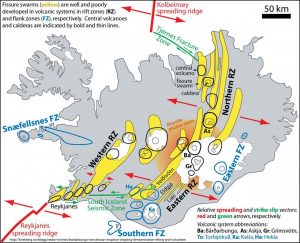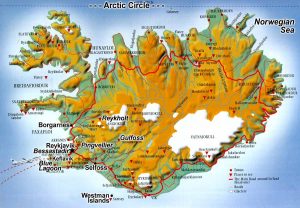VIU’s intrepid GEOL 390 class are on a field trip to explore the geology of Iceland and will be reporting their daily activities using this blog. The plan, over the next ten days, is to travel to most regions of Iceland and examine the wide range of geological phenomena: from fissure swarms, volcanic centres to glaciers. Of special interest will be the amazing interaction between glaciers and active volcanism that can result in features such as mobergs ridges and large outwash events or jokulhaups.
Iceland is a geological unique place in the world, whereby a mid-oceanic ridge (a spreading centre where two plates are moving apart) occurs in the same place as a mantle plume or hot spot. The combination of these two results in an upwelling of magma material that forms a large island – Iceland. Iceland, which is 400 km by 500 km with elevations of up to 3000 m, is geologically very young – only 24 million years old. (Much younger than the last terrane which collided and joined onto the southwest coast of Vancouver Island 40 million years ago).
Iceland is seismically and volcanically very active, and connects two spreading segments of the Mid-Atlantic Ridge as shown on the tectonic map– the Reykjanes segment to the southwest of Iceland and the Kolbeinsey segment to the north. The link between these two spreading segments crosses the land of Iceland. This is not a simple connection, but is rather a complex arrangement of rift (pull apart) zones with fissure swarms and volcanic centers, that are separated by sliding transform fracture zones. Many of these volcanic centers occur near to the current location of the mantle plume. The result of this intense volcanic activity are numerous geothermal areas, some of which we plan to explore and hopefully immerse ourselves in occasionally – thermal swimming pools.
From the topographic map, it is possible to see the real extent of Iceland from the highland area with glaciers in the centre of the island, leading down to the ford lands and the lowlands along the coast, all related to extensive glacial erosion and outwash events.
Our first day will be along the Reykjanes Peninsula to the southwest, from where we will travel along the South Road to the eastern side of Iceland. From here we will return to the Westman Island (a short ferry ride), and then travel to the northwest and the Snaefellsness Peninsula, eventually ending up in the north of Iceland and Akueyri and Lake Myvatn, close to the Arctic Circle. It is then a short journey back to Reykjavik! All to be done in 10 days – no way near enough time. Long daylight hours will help, but cooler (5-15C) and wetter weather might be a challenge!

